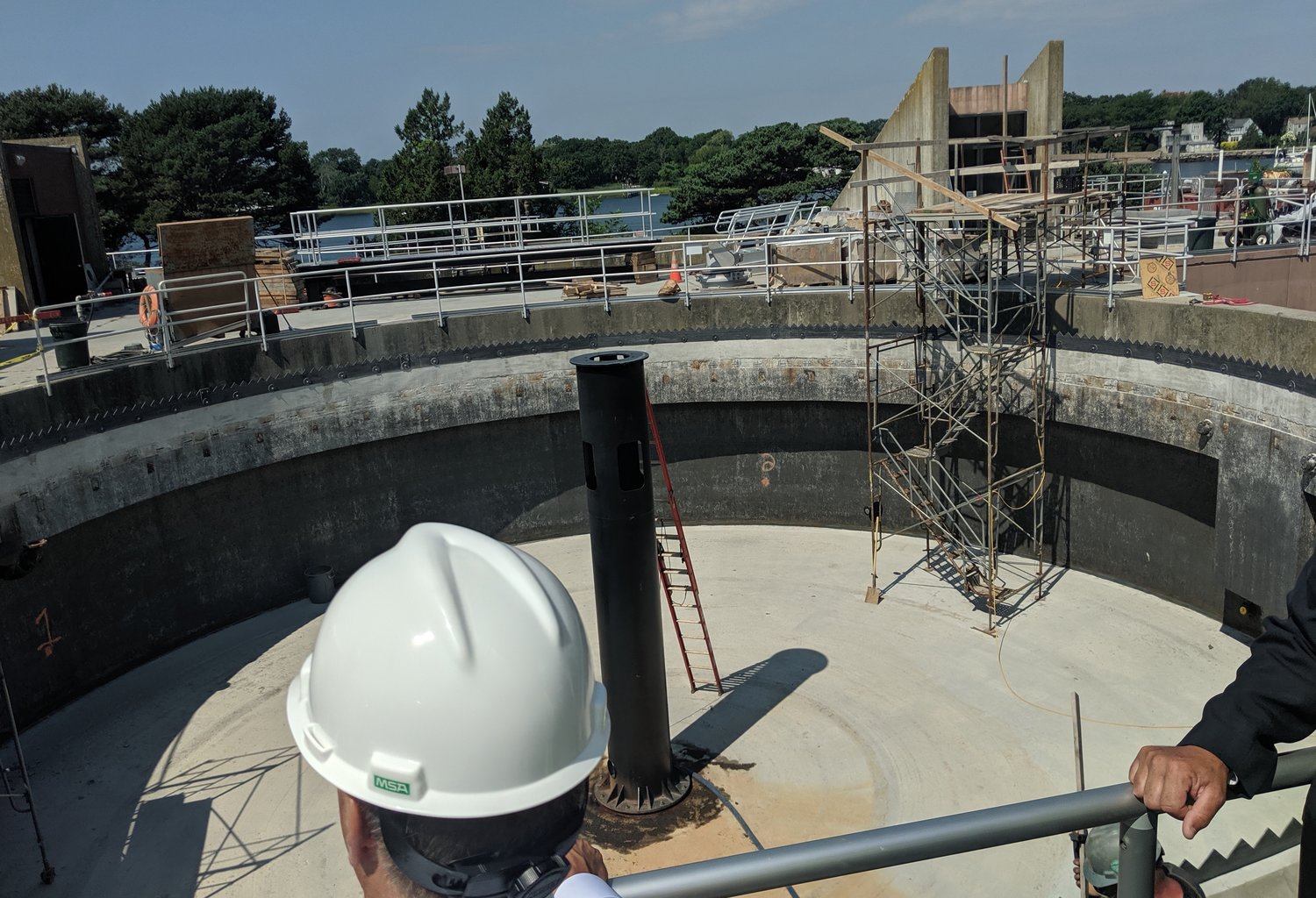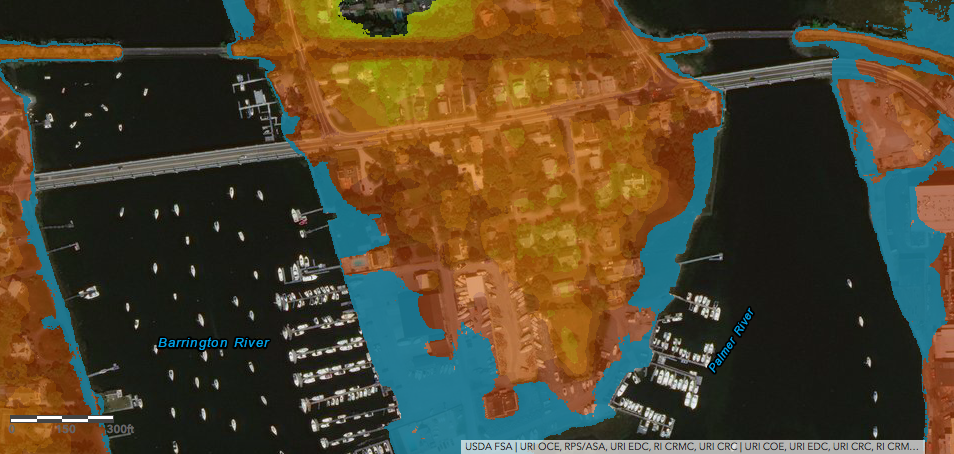By TIM FAULKNER/ecoRI News staff

A solid-waste separation tank at the sewage treatment plant in Warren, R.I., was raised to 16 feet to withstand a 100-year storm and sea-level rise. (Tim Faulkner/ecoRI News)
An innovative program has five Rhode Island communities talking about and taking action on climate change.
Barrington, Portsmouth, South Kingstown, Warren, and Westerly are all at various stages of planning adaptation projects, such as protecting sewage treatment facilities and preserving salt marshes and woodlands.
The Municipal Resilience Program, run by The Nature
Conservancy and the Rhode Island Infrastructure Bank, is offering $2 million to
seed a range of nature-based and manufactured adaptation plans.
The concept is modeled on programs in Massachusetts and Connecticut that look for achievable efforts cities and towns can collectively approve and complete, such as dam removal, road elevation, micro electric grids, stormwater management, backup power, tree planting, and coastal erosion control.
The concept is modeled on programs in Massachusetts and Connecticut that look for achievable efforts cities and towns can collectively approve and complete, such as dam removal, road elevation, micro electric grids, stormwater management, backup power, tree planting, and coastal erosion control.
The intent of the Rhode Island program is to identify worthy
projects and see that they get done.
“It’s making sure it’s not just another plan,” said Sheila Dormody, government relations and cities program manager for the Rhode Island chapter of The Nature Conservancy. “It’s real projects to deal with the impacts of climate change.”
No projects have been selected yet, but The Nature Conservancy is
gathering new ideas and discussing existing proposals at community meetings.
Portsmouth and South Kingstown completed the workshops. Westerly ha one on Aug. 22. Barrington and Warren are collaborating on a single
project and are expected to hold a joint meeting in September.
All five towns have a high risk of flooding and other perils from
sea-level rise and from more intense and frequent storms.
“When you look at the projections, it’s mind-boggling,” Barrington
town planner Phil Hervey said.
Hervey said priority projects include addressing existing tidal
flooding on the Wampanoag Trail, a major thoroughfare to Providence, and
anticipated flooding at the approaches of the town’s three major bridges.
Coastal threats, however, aren’t always the top issues raised at the public meetings.
South Kingstown suffered major beach erosion and lost buildings
during Hurricane Sandy in 2012.
Bitter debates about coastal development, beach sand, and a seawall on Matunuck Beach Road dominated the recovery effort.
Bitter debates about coastal development, beach sand, and a seawall on Matunuck Beach Road dominated the recovery effort.
But during a public workshop in June, residents shared concerns about forest protection and tree management. Some 30 percent of the community is protected land, and issues were raised about using trees for carbon sequestration and temperature control.
Pruning trees to protect power lines and reduce electricity outages was also a topic.
“There’s a whole lot more to South Kingstown than the coast,” said Kaela Gray, the town’s interim planning director.
On Aug. 14, government officials celebrated a climate-change renovation to the sewage treatment plant in Warren. Submersible pumps replaced outdated ones. Open-air tanks and electrical equipment were elevated to 16 feet to withstand a 100-year storm, plus 3 feet of sea-level rise and additional storm surge.
The state’s smallest town is one of the most threatened by rising seas, flooding, storm surge, and other coastal problems brought by climate change. Most of the town is boarded by salt marsh or densely built commercial and residential waterfront lined with docks, and steel and stone seawalls.
The $21.7 million project at the sewage treatment facility wasn’t the result of the Municipal Resilience Program, but serves as the type of project that high-risk communities with modest financial resources like Warren can embrace as the first of many steps needed to protect key, and often unappreciated, services such as stormwater and sewage management.
“To the public, it’s not exciting until you can’t flush,” Warren planning director Robert Rulli said.
Some solutions are harder to implement than fortifying seawalls and elevating buildings. Warren’s northern boarder, for instance, is edged by miles of salt marsh along the encroaching Palmer River.
Storm drains and culverts on busy commercial roads routinely flow in reverse during seasonal high tides. Solutions such as buying out homes as part of a managed retreat or somehow redirecting floodwater into open areas like a nearby park requires more sophisticated engineering and political will.
“There’s no quick, easy option or inexpensive option,” Rulli said.
“None of them are easy or palatable.”
Portsmouth has similar problems in the low-lying, densely built
residential neighborhoods of Common Fence Point and Island Park.

A 100-year storm, highlighted in orange, and 3 feet of sea-level
rise, shown in blue, floods the land and blocks the bridges that connect
Barrington and Warren. (STORMTOOLS)
“Do we protect houses or do we protect marshland?” asked Raymond
J. Perry, emergency management director for Portsmouth.
At the town’s July 25 workshop, environmental and political issues
were raised by residents who typically don’t discuss big-picture concepts such
as relocating homes and open-space management.
“It started conversations on some very, very complex issues on all
levels,” Perry said.
The solutions will draw from and be included in the town’s
comprehensive and emergency management plans. Getting them built will likely
require help and money from federal entities such as the Army Corps of
Engineers and the National Oceanic and Atmospheric Administration.
“The devil in the details can come later,” Perry said. “Right now
we need to start the conversations.”
Westerly’s shoreline was also ravaged by Sandy. Some businesses
never returned and others rebuilt on mobile structures. The town is going ahead
with a project to build a protective berm at a wastewater treatment facility.
The town’s Department of Public Works is evaluating infrastructure
for climate-change impacts and resiliency in all aspects of the comprehensive
plan.
Nancy Letendre, Westerly’s town planner, is grateful that the
Municipal Resilience Program is moving projects forward through community
engagement.
“People have recovered from Sandy; now what we are working on is
getting prepared for resiliency and protecting infrastructure and the economic
vitally of the community,” she said.
The Municipal Resilience Program requires municipalities to match
25 percent of the funding it receives from the Infrastructure Bank. Funds will
be distributed over two years. After the communities complete the program, at
least $1 million will be allocated through a request for proposal (RFP) in
2019.
The remaining money will be extended to the communities in 2020.
The remaining money will be extended to the communities in 2020.
Shaun O’Rourke, director of stormwater management and resiliency
at the Infrastructure Bank, will help communities identify projects for the
RFP, and create a pipeline of projects that can be built in the future.
O’Rourke also wants inland and urban communities to join the
program.
“These resiliency issues are not coastal,” he said. “They are
truly a statewide issue.”